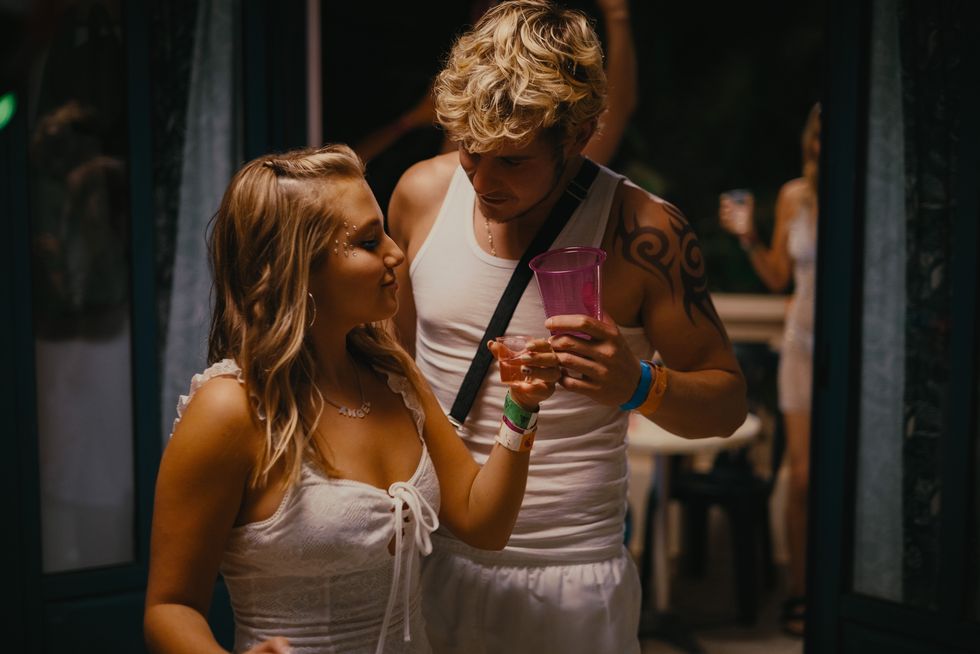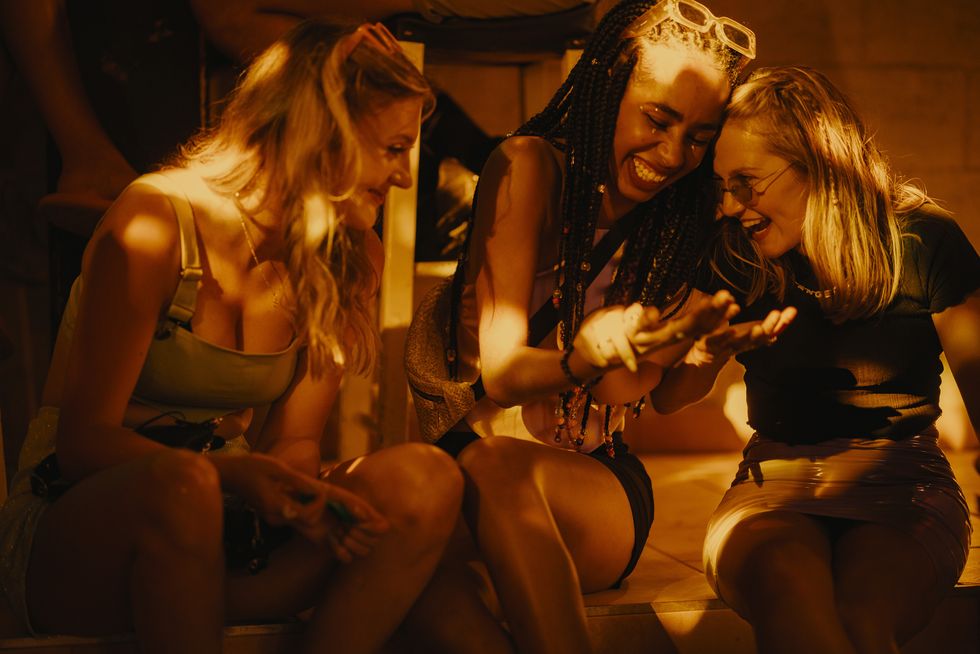Breakout Film How to Have Sex Is Changing How We Talk About Consent Onscreen
This story contains discussions of sexual assault. If you or someone you know needs support, contact the National Sexual Assault Hotline at 800-656-HOPE (4673) or visit rainn.org.
Spoilers below.
There’s a scene in Molly Manning Walker’s How to Have Sex—a neon-hued treatise about consent—where teenagers Tara (Mia McKenna-Bruce) and Badger (Shaun Thomas) are dancing, drinking, and flirting at a party until volunteers from the crowd are requested onstage. Badger offers himself up, but what he inadvertently signs up for is a “get hard” contest where multiple women end up giving him a blow job in front of hundreds of people. It feels like something that would never happen in real life, but it’s actually something that Manning Walker had witnessed during a vacation in her teens.
The scene is one of the myriad ways Manning Walker’s feature debut explores the thorny issues surrounding consent. And it does so while following three friends, Tara, Skye (Lara Peake), and Em (Enva Lewis), who take a trip to Malia to have a wild break full of booze and boys, as Tara attempts to have sex for the first time—which ultimately happens when a boy sexually assaults her.
What could be a typical, cut-and-dry look at sexual assault is instead a nuanced, zoomed-out portrait of how many factors, like peer pressure and FOMO, can create an environment—and in a larger scope, a culture—where assault becomes common. Manning Walker, who wrote and directed the film, wanted to change the ways we talk about assault and consent, because it’s not just the scenario between perpetrator and victim. She was interested in “how we’ve learned to have sex as a society,” the pressures we—especially women—put on each other, the effects of toxic masculinity, and how normalized these experiences are. “We need to rewrite the way that we’re talking about sex completely,” Manning Walker says.
The film explores how assault doesn’t just live in a vacuum; so many different elements can weigh in, from the spring break setting to party culture as a whole. It’s an approach rarely, if ever, shown in contemporary media, and for many actors starring in the film, that was the draw. “I fell in love with Molly’s script,” says McKenna-Bruce, who gives a star-making performance as Tara. “It was a film that I wish I had had when I was younger, and I’ve got two younger sisters, so it is something that I really wanted them to watch, so I thought to get ’em to watch it, I’ll try and be in it,” she laughs.
Other members of the cast also wished their younger selves had seen the film. In fact, they shared deep discussions during extended rehearsal time in Malia, which helped them prepare for filming. “Everyone was so open to talk about their own experiences and their own views on things and challenge each other’s views on things as well, which I think was really important,” Lewis says.
Lewis’ character Em is a part of the core trio of friends who let loose in Malia after exams. But even their friend group becomes affected by–and a breeding ground for–the pressures to have sex. They clearly love and care for one another, but Skye can be cruel to Tara specifically. Skye seems more invested in Tara losing her virginity than Tara even is, always making snippy comments about her inexperience. She even tries to change Tara’s mind by saying Badger is unworthy of her, but Paddy (Samuel Bottomley) is. “She’s gotten so close to Tara that she knows her weak spot, and she knows how to manipulate that,” Peake, who plays Skye, says of the character. The result is a pressure cooker for Tara.
When Paddy eventually invites Tara to go with him down to the beach, things curdle rapidly. She consents to sex with Paddy, but her body language is clearly saying something else. The assault is hard to watch, because it’s a realistic portrayal that many women have experienced that’s filled with nuance. Yet, Paddy probably wouldn’t characterize himself as a “bad guy,” says Bottomley, the actor that plays him. “[It’s] more of a mental thing for my character than anything else, just getting into the fact that he doesn’t think what he’s doing is wrong, and he thinks, to a certain extent, that he deserves it or he’s earned it or it belongs to him.”
And that’s something How to Have Sex does does differently from so many other pieces of media that explore consent—it really delves into the roles that men play in these scenarios: Badger’s experience at the “get hard” contest, which he has no recollection of the next morning, can read as its own kind of assault. Paddy insists he’s owed sex from Tara after what happens between them at the beach. Badger calls Paddy a nightmare and clearly knows something happened between him and Tara but doesn’t do anything to protect her or call out his friend.
Exploring how men play a role was very important—especially when portraying assault in real terms on film, where it’s not hyper-stylized or -sexualized. Manning Walker aimed “to make something that allowed men to recognize their own behavior in it, rather than being able to detach and say, ‘That’s not me. That’s a really horrible, nasty guy that I don’t associate with.’ It’s like, no, these are the guys that are in our lives and that have been in our lives.” She wanted to make men accountable and show them in a realistic light, to allow for them to feel like they should be involved in these conversations around consent.
It seems to be working. After a screening of the film in France, Bottomley recalls, “There was this man and he was pacing around outside the theater and really upset. He told Molly, ‘I’ve done that. I’ve been that guy.’ He was an older man, and I think it rocked him a bit. For man to get to that age and not really realize what he’s done, that’s powerful isn’t it?”
“It goes into more depth than someone just saying yes or no. It’s showing the body language and the aftermath,” Thomas says. “So I think it’s a massive eye-opener, and I think men can really learn from it.”
But Manning Walker doesn’t want to point fingers in just one direction; instead she wants the film to rewrite how we all talk about and view sex, consent, and the factors that play into them. “I think it was [about] not wanting to blame anyone for this and understanding that, like we said before, it’s how we’ve learned how to have sex wrong and that society’s taught us so much about what a female experience should be like, or talks about male pleasure, but never talks about female pleasure,” she says. “Because of that lack of information and lack of communication around it, we push each other into situations that we don’t know. We didn’t want to lock anyone out of the conversation, so we wanted to make sure that no one was blamed for it, that it was talking about a societal issue.”
“I’ve never had this many conversations with people about assault and consent and sex generally,” Lewis adds. “It’s so lovely to see everyone kind of share this same thought of like, ‘I need to wake up a little bit. I need to think about what I’m doing a little bit more.’ We’ve created a culture that allows what they’re doing in a sense. We need to think about how we are contributing to it.”
How to Have Sex is now playing in select theaters. Get Tickets




